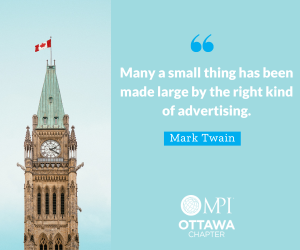Studying for the Certified Meeting Professional exam? MPI Ottawa has you covered!
Learn More
Check out all the exciting events taking place in the upcoming 2023/2024 year!
Learn More

Creating Meetings with Purpose

What makes a meeting “purposeful”? Often we hear words like innovative, purposeful and insightful being used to brand the experiences created at events but what do these really mean and how do we measure our success against these types of goals?
Experts in the event industry recognize five tangible areas where planners, designers and marketers can focus their efforts to create a more purposeful experience. Utilizing research in the areas of behavioural science, meeting and event design, health and well-being, CSR and positive impact and finally technology we can begin to see how purpose can be better established.
Behavioural Science: Recent neuroscientific discoveries relating to how the conscious and non-conscious brain works has given us the insight to reposition typical event outcomes such as learning, networking and pleasure in order to create experiences that foster deeper meaning, creativity and authenticity. Through the application of our behavioural science knowledge and these new breakthroughs, we can better leverage how the brain works in social settings to create more purposeful experiences.
Health and Well-being: Like we learned with Lee Papa last month, it is becoming more and more common to incorporate things like healthy nutrition, mindfulness practices, relaxation and healthy sleep guidelines into events. These types of practices have not only been shown to help people better manage anxiety symptoms, but have also shown an increase in the number of hours asleep and overall feelings of peacefulness and happiness.

Meeting and Event Design: Light, air, sound, smell and touch should all be managed intentionally. By better understanding behavioural science of how we may react or learn in different environments, we can enhance peak performance and attendee experiences through the senses and timing. A balanced agenda should be the right mix of content, networking, free time, and reflection; designing the space with the intention of utilizing the human multi-sensory experience to your advantage.
CSR, Legacy and Positive Impact: Millennials are leading the shift in thinking about the typical corporate social responsibility (CSR) experience with a focus to “rethink, reduce, reuse and recycle” when it comes to the impact our meetings make, combined with recognition of the power of community connection. Community engagement programs are becoming increasingly common, where affiliation with a local, non-profit organization for a large meeting or event is becoming the norm in an attempt to minimize negative impacts.

Technology: There is no denying that technology has changed the way we connect and do business. In the meeting industry this is no different; the smart meeting planner is keeping pace with the new resources that have enabled more efficient ways to collect data, analyze, deduce and extrapolate. Not only this, but there are numerous apps and tools available to create shared-thought experiences, reduce anxiety, exchange information, socialize and more. Continuing to test and evaluate various emerging technologies will set purposeful meeting planners apart from their peers.
Sharon Fisher, CEO/IdeaSparkler at Play with a Purpose, shared a tool to facilitate the development of a framework you can use for each event to determine the purpose (vision and goals) for the experience. Completing this tool in the early planning stages will allow you to reference it along the way as you make decisions regarding programming, opportunities, added features, and more. You can ask how does this support the values and goals that we outlined when we started? If a speaker or breakout session or meal item does not support the framework, it makes the decision to look in another direction much easier. At the end of the event, the goal is that you will have designed an event that successfully hit the target values originally outlined.

In summary, this simple worksheet is broken into 3 columns. The key is to take a big picture approach as opposed to detailed logistics. You are looking to set the stage for how each piece will integrate and tie together. In the example below, imagine you are organizing an incentive trip to reward your company’s top performers.
|
LEARN/KNOW What are the most important takeaways that we want our audience to walk away with? |
FEEL/THINK What do we want them to feel or think about based on the key messages? |
DO What, if any actions (or next steps) do we want them to take? |
|
The work they do is important |
Valued |
Go back to work energized, to hit the ground running and continue preforming at a high level |
|
Hard work is rewarded |
Appreciated |
Leverage stronger team relationship to increase efficiency and performance |
|
The company is concerned with the well-being, motivation and happiness of their employees |
Taken care of |
|
|
Build stronger relationships within the team |
Relaxed and re-energized |
|
|
|
Excited to hit high sales numbers again |
|
|
|
They are part of a team that cares about them |
|
Organizers are told to create a clear vision of what they want to achieve from a given event, but are sometimes at odds with the c-suite (be that board of directors, top-level management, attendees, other stakeholders) in terms of successfully determining the most important priorities and expectations of the meeting. Facilitating honest discussions between these decision makers is key to design a meeting that has purpose. Using your roapmap above, when someone comes to you with an outside the box idea, asking why repeatedly is a good technique to tease out the underlying reason or thought processes of a decision maker. If they tell you halfway through planning that their priority at the end of the incentive trip is that all sales staff know the competitive advantages of the brand new product line. Re-frame their response into a why question. Why is that important for this meeting? Continue to reference your framework to determine what makes sense to include in the meeting.
This is true for budget management as well. Are we allocating our budget effectively, based on our goals? If the top priority of a meeting is to educate the attendees on a particular topic, but you have allocated more than 80% of the funds to food & beverage and decor then you are not doing a great job at meeting your purpose.

At the end of the day, our stakeholders want some way to look at the event and say, “well...did it work? What was the ROI?” Outlining the purpose of the meeting in advance allows you to define early on how you will tell that it was successful and how you will know you met your objectives. This could be a certain sales number, successfully training a new skill, networking with x new colleagues, etc. What do we expect to see happen when the attendee leaves? What was the purpose of bringing them together in the way that we did? By defining these more arbitrary values in advance, it makes it so much easier to look at the big picture of the event. Value can’t be measured if it is not clear what we are measuring against. Try using the LEARN, FEEL, DO tool, along with the five main areas noted above to see if it helps more clearly define your goals and objectives in order to create a more purposeful experience.


Article by: Katherine Craig, The War Amps
Article edited by Rozanne Lyons, CMP, Intertask Conferences


Leave a commentOrder by
Newest on top Oldest on top